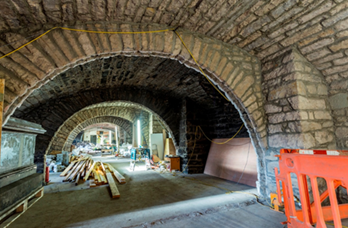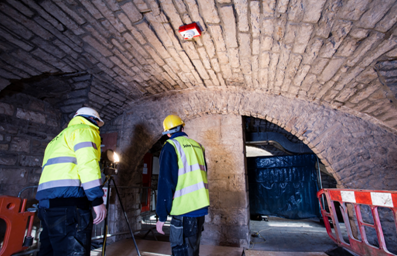Fire safety in ecclesiastical and heritage buildings
 Paul Henson, Sales and Marketing Director at Ramtech Electronics, explores how guardians of our ecclesiastical and heritage buildings can set a benchmark for fire safety by specifying an EN 54 compliant temporary fire alarm systems.
Paul Henson, Sales and Marketing Director at Ramtech Electronics, explores how guardians of our ecclesiastical and heritage buildings can set a benchmark for fire safety by specifying an EN 54 compliant temporary fire alarm systems.
“Fire in our ecclesiastical and heritage buildings is an ever present danger. These types of structures are particularly vulnerable during refurbishments or new build work due to the presence of flammable materials and hot works’’
The resulting damage from a fire does not stop at physical property loss. A major concern is that most of the building work is undertaken whilst the church remains fully functioning. In these situations, not having a fully compliant fire alarm system can result in unnecessary risks from a fire to the congregation and other building users.
An additional factor to consider is that several of the leading insurers to the ecclesiastical and heritage sector require that adequate consideration is given to fire during any building work. However, it is not prescriptive on what ‘adequate’ means. Subsequently it complies that the fire alarm system meets EN54 as standard.
EN 54 compliance
The dangers of fire during building and refurbishment work was one of the reasons why more stringent legislation around fire safety has been introduced. The latest of these CPR (Construction Products Regulation), provides clear guidance on the performance of all construction products; to comply, fire detection and alarm systems must be specifically engineered - and independently tested and approved - to comply with EN54.
The reason for having a technology-based fire alarm – rather than relying on a person sounding an audible alarm – is that human nature in a real emergency is difficult to predict. It also relies on the person being present when the fire occurs, which can be difficult in large, complex buildings that have grown and evolved over the centuries.
 The first response by those closest to the fire is to move away before alerting others. However, when seconds count, not instantly sounding an alarm may further restrict exit routes to personnel in other areas of the building. An automated fire alarm, which is capable of immediately detecting heat and smoke, and alerting the whole site, could make all the difference in this scenario. These, automated procedures based on fully EN 54 compliant technology results in reduced risk to people and enhanced protection of our architectural heritage.
The first response by those closest to the fire is to move away before alerting others. However, when seconds count, not instantly sounding an alarm may further restrict exit routes to personnel in other areas of the building. An automated fire alarm, which is capable of immediately detecting heat and smoke, and alerting the whole site, could make all the difference in this scenario. These, automated procedures based on fully EN 54 compliant technology results in reduced risk to people and enhanced protection of our architectural heritage.
Wireless technology
Whether the fire alarm system specified is wired or wireless, it must still comply with EN54. Wireless fire alarm systems have the distinct advantage in that they avoid the need for specialists required with wired versions, both during set up and subsequent repositioning of the units as building and refurbishment work progresses.
An EN 54 wireless fire alarm system is also highly suited to ecclesiastical and heritage buildings because it is not possible to drill into walls and ceilings. Conversely, with a wired system, the ability of the wireless signal to pass through all solid materials found on site avoids the need completely for cabling.
 An EN 54 compliant wireless fire alarm system comprises of manual call points and/or automatic heat/smoke detectors, linked to a monitoring base station. In the event of a fire, the system triggers a high volume siren and a visual strobe light, alerting personnel to evacuate the site. At the same time, the base station allows the fire officer to instantly identify which fire point or detection unit has been activated, allowing emergency services to be deployed more effectively to the exact source.
An EN 54 compliant wireless fire alarm system comprises of manual call points and/or automatic heat/smoke detectors, linked to a monitoring base station. In the event of a fire, the system triggers a high volume siren and a visual strobe light, alerting personnel to evacuate the site. At the same time, the base station allows the fire officer to instantly identify which fire point or detection unit has been activated, allowing emergency services to be deployed more effectively to the exact source.
The base station can also provide SMS text alerts in the event of an alarm being activated allowing personnel to keep tight control on fire safety when they are off site, providing 24 hour protection. Once the project is complete, the system, which requires no cables and is battery-powered, can be moved to the next project and reconfigured via the app.
Case file: St John’s Edinburgh
St John’s Episcopal Church, Edinburgh, built in 1818, specified our WES+ wireless fire alarm system predominantly because it is EN 54 compliant. The refurbishment and extension includes a mezzanine floor to the church hall, retail units and other improvement works. The vaulted crypt, with its confined spaces and restricted sightlines as well as the fact that the church remains fully functioning during the works were very good reasons why the church committee and contractor specified an EN 54 compliant wireless fire alarm system.
 There were specific concerns in the vaulted crypt because a fire may not have been immediately visible due to the low, arched ceilings.
There were specific concerns in the vaulted crypt because a fire may not have been immediately visible due to the low, arched ceilings.
One of the factors that dissuaded the company from choosing a wired fire alarm system was the time it would have taken to reposition the units as building works progressed. “When we sat down with our surveyors and looked at the cumulative effect of moving the wired units, it added a number of days to the schedule,” said Stewart Carney, Managing Director at John Dennis (Scotland) Ltd. “A wireless system proved to be much more user friendly.”
Conclusion
EN 54 compliant wireless fire alarm systems set the benchmark when it comes to protecting personnel and assets on any construction or refurbishment project. They are easy to install and operate, with zero installation costs and a battery life of approx. 3 years. As more churches look to make better use of their space through refurbishment and redevelopment, an EN 54 compliant fire alarm system provides them with the best way of carrying out the work safely, protecting both people and our architectural heritage.”
For more information on Ramtech Electronics and WES+, visit: www.wesfire.co.uk or call 00 44 (0) 115 957 8282